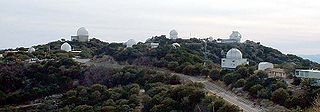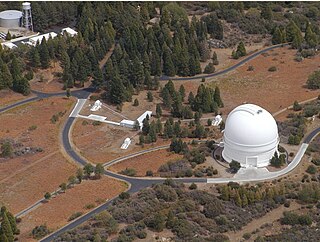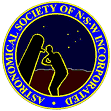
The Kitt Peak National Observatory (KPNO) is a United States astronomical observatory located on Kitt Peak of the Quinlan Mountains in the Arizona-Sonoran Desert on the Tohono O'odham Nation, 88 kilometers (55 mi) west-southwest of Tucson, Arizona. With more than twenty optical and two radio telescopes, it is one of the largest gatherings of astronomical instruments in the northern hemisphere.

An observatory is a location used for observing terrestrial, marine, or celestial events. Astronomy, climatology/meteorology, geophysical, oceanography and volcanology are examples of disciplines for which observatories have been constructed. Historically, observatories were as simple as containing an astronomical sextant or Stonehenge.

Palomar Observatory is an astronomical research observatory in San Diego County, California, United States, in the Palomar Mountain Range. It is owned and operated by the California Institute of Technology (Caltech). Research time at the observatory is granted to Caltech and its research partners, which include the Jet Propulsion Laboratory (JPL), Yale University, and the National Optical Observatories of China.
The Astronomical Society of the Pacific (ASP) is an American scientific and educational organization, founded in San Francisco on February 7, 1889. Its name derives from its origins on the Pacific Coast, but today it has members all over the country and the world. It has the legal status of a nonprofit organization.

The Kopernik Observatory & Science Center (KOSC), is a public observatory in Vestal, New York opened to the public on 16 June 1974 by the Kopernik Society of Broome County to commemorate the 500th anniversary of the birth of the astronomer Nicolaus Copernicus in 1973. Its mission is to offer hands-on investigations and outreach programs for educating all ages about astronomy and science using advanced optical telescopes, computers and other tools. It is the first science laboratory facility in New York State designed for K-12 teachers, students and their families, and has been one of the best-sited and best equipped public observatories in the Northeast United States for nearly the last 40 years.

The Institute of Astronomy (IoA) is the largest of the three astronomy departments in the University of Cambridge, and one of the largest astronomy sites in the UK. Around 180 academics, postdocs, visitors and assistant staff work at the department.

The James Richard Jewett Observatory is an astronomical observatory owned and operated by Washington State University. It is located in Pullman, Washington (US). It houses the largest refracting telescope in the state of Washington. The 12-inch lens was originally ground and polished between 1887 and 1889 by Alvan Clark & Sons for an amateur astronomer, who died before the telescope could be assembled. The lens was put into storage, and was purchased by the university when it came up for auction in the 1950s. Its present dome was dedicated in 1953 and it is named after the father of a supporter of the observatory, Mr. George Jewett of Spokane.

Judson B. Coit Observatory is an astronomical observatory owned and operated by Boston University on the roof of the College of Arts & Sciences at 725 Commonwealth Avenue in Boston, Massachusetts, USA. The observatory is used in undergraduate and graduate courses of the Boston University Department of Astronomy, and for observing projects of the Boston University Astronomical Society.

Hopkins Observatory is an astronomical observatory owned and operated by Williams College in Williamstown, Massachusetts (USA). Constructed in 1838 by Albert Hopkins, the college claims that it is the oldest observatory in the United States.

Martz Observatory is a public, not-for-profit organization devoted to the amateur astronomer. The emphasis of the association is observational astronomy, well-rooted in public education and enjoyment of the starry skies. It was founded by, and eventually named after, Marshal Martz, an amateur astronomer from Jamestown, NY who built the first large telescope ever used at the observatory.

C.E.K. Mees Observatory is an astronomical observatory in Bristol, New York, owned and operated by the University of Rochester. The observatory is named after C. E. Kenneth Mees, "in honor of his pioneering work in the development of sensitive photographic emulsions for use in astronomy."

Brooks Observatory is an astronomical observatory owned and operated by the University of Toledo. The observatory is used primarily for public viewing and undergraduate instruction. It hosts an array of small telescopes, the centrepiece of which is a Celestron 14 Edge HD. It is located on the campus of the University of Toledo in Toledo, Ohio (USA), occupying the 6th floor of McMaster Hall, home to the Department of Physics and Astronomy.
Brooks Astronomical Observatory is an astronomical observatory owned and operated by Central Michigan University. It is located in Mount Pleasant, Michigan (USA). The observatory was established in 1964 and is located on the roof of the Brooks Hall science building. Both the building and observatory are named for Kendall P. Brooks, instructor of astronomy and other subjects in the period of 1910-1947.
The Royal Astronomical Society of Canada (RASC) is a national, non-profit, charitable organization devoted to the advancement of astronomy and related sciences. At present, there are 28 local branches of the Society, called Centres, in towns and cities across the country from St. John's, Newfoundland, to Victoria, British Columbia, and as far north as Whitehorse, Yukon. There are about 5100 members from coast to coast to coast, and internationally. The membership is composed primarily of amateur astronomers and also includes numerous professional astronomers and astronomy educators. The RASC is the Canadian equivalent of the British Astronomical Association.

The University of Illinois Astronomical Observatory, located at 901 S. Mathews Avenue in Urbana, Illinois, on the campus of the University of Illinois at Urbana–Champaign, was built in 1896, and was designed by Charles A. Gunn. It has been listed on the National Register of Historic Places since November 6, 1986, and on December 20, 1989, was designated a National Historic Landmark.

The Hirsch Observatory is an astronomical observatory at Rensselaer Polytechnic Institute (RPI) in Troy, New York. It is located on the roof of the Jonsson-Rowland Science Center and is used by members of the Rensselaer Astrophysical Society as well as astronomy students in laboratory exercises. It is frequently opened to the community for public viewing sessions. The observatory's main dome contains a 16" Cassegrain Reflector, with a CCD camera and fully computerized controls. The observatory also owns a variety of smaller scopes and a SBIG Spectrograph. The spectrograph has been used to catalog bright solar spectrum as part of an effort to create an online digital database for astrophysical research. The current director of the observatory is Professor Heidi Newberg.

Fuertes Observatory is an astronomical observatory located on the North Campus of Cornell University in Ithaca, New York. The observatory was designed by L.P. Burnham, Cornell Professor of Architecture and completed in fall of 1917. It was originally used by the Civil Engineering Department as an instructional field office for navigation and surveying. Today, the observatory is primarily used for public outreach, welcoming over two thousand visitors per year with open houses on clear Friday nights.

The Dark Sky Observatory (DSO) is an astronomical observatory owned and operated by Appalachian State University (ASU). It is located 9 kilometers (5.6 mi) east of Deep Gap, North Carolina (USA), off of the Blue Ridge Parkway, and 32 kilometers (20 mi) east of the ASU campus in Boone, North Carolina It was established in 1981, and is used for research, instruction, and public viewing events. The Cline Visitors' Center was completed in 2011.

A public observatory is an astronomical observatory mainly dedicated to public and educational purposes. It is often supported by a municipality, a school or an astronomical society.

The Astronomical Society of New South Wales (ASNSW) is an amateur astronomy club in the state of New South Wales, Australia. It was founded in 1954 and it has over 400 members.















